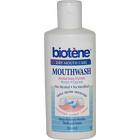- Capable of reducing plaque scores by 20-50%.
- Overall plaque reduction by 70-90% and exhibit slow release properties.
- Exhibit better retentive properties over second generation agents.
Triclosan and Chlorhexidine has been widely used in recent mouthwashes. Triclosan
delays plaque maturation and inhibits formation of prostaglandin leukotrines which
is a key controller of inflammation. Chlorhexidine acts against plaque and bacteria.
-
Prevents pellicle formation by blocking acidic groups on salivary glycoproteins
and reducing glycoprotein adsorption on tooth surface.
-
Prevents adsorption of
bacterial cell wall on tooth surface.
-
By binding to the bacteria.
-
Prevents binding of mature plaque by precipitating agglutination factors in the
saliva and displacing calcium from the plaque matrix.
- Bacteriostatic (low concentration).
-
Bacteriocidal (high concentration).
Mouthwashes, when used in conjunction with a regimen of effective tongue cleaning,
tooth brushing and flossing, can play a role in the treatment of bad breath (halitosis).The
effectiveness of a mouthwash will be founded on its possessing one or both of the
following characteristics:
-
Anti-bacterial mouthwashes- It has an ability to kill bacteria and plays
a part in helping to minimize the total number of anaerobic bacteria that are present
in oral cavity. Since these bacteria are the source of the volatile sulfur compounds
that cause bad breath, the fewer of them that are present in a person's mouth the
better.
-
Mouthwashes that neutralize volatile sulfur compounds- The ingredients found
have the capability to neutralize volatile sulfur compounds (VSC's) and/or the compounds
from which they are formed. Since volatile sulfur compounds are the malodorous substances
that actually cause bad breath, if a mouthwash decreases the concentration of these
compounds, then the more pleasant that person's breath will be.
Some of the different types of over-the-counter mouthwashes that have been created
for the treatment of bad breath are listed below:
- Antibacterial and neutralizes volatile sulfur compounds.
-
Mouthwashes that contain chlorine dioxide or its parent compound sodium chlorite
cure bad breath. Research has suggested that the action of chlorine dioxide's mechanism
is twofold:
-
-
Chlorine dioxide is an oxidizing agent (this means that it releases oxygen). Because
most of the bacteria that cause bad breath are anaerobic (meaning, they prefer to
live in environments devoid of oxygen), exposing them to an oxidizing agent can
help to minimize their numbers.
-
Chlorine dioxide has the ability to neutralize volatile sulfur compounds. It also
has the ability to degrade the precursor components utilized by bacteria use when
making VSC's. The net effect is that the overall concentration of volatile sulfur
compounds found in a person's breath is reduced and as a result their breath will
be more pleasant.
-
Antibacterial
"Antiseptic" mouthwash has been suggested as suitable product for the treatment
of bad breath. The effectiveness of this type of rinse is related to its ability
to kill the anaerobic oral bacteria that produce volatile sulfur compounds. Antiseptic
mouthwash has not been shown to have a neutralizing effect directly on the volatile
sulfur compounds themselves.
Mouth rinses serve a variety of purposes-
-
Antiplaque/Antigingivitis Rinses
-
Therapeutic Antiseptics
- Phenol products: Listerine, Chloraseptic
-
Chlorhexidine products: Peridex,
Corsodyl
- Sanguinaria products: Viadent
-
Cosmetic antiplaque rinses: Plax, Close-Up
Anti-Plaque
-
Therapeutic Anticavity Fluoride Rinses Act+, Fluorigard+, Listermint with Fluoride
-
Cosmetic Breath Freshening Mouth Rinses
Cepacol, Lavoris, Scope, Signal, Clear Choice, Rembrandt Mouth Refreshing Rinse
-
Others
- Topical antibiotic rinses
- Enzyme rinses
- Artificial saliva rinses
-
Rinses that control tartar (the hard, crusted calcium deposits that form on teeth.
Cosmetic rinses are commercial over-the-counter (OTC) products that help remove
oral debris before or after brushing, temporarily suppress bad breath, diminish
bacteria in the mouth and refresh the mouth with a pleasant taste.
Therapeutic rinses also can be categorized into types according to use:
- Antiplaque/antigingivitis rinses
- Anticavity fluoride rinses.
Therapeutic mouth rinses as chemical antiplaque agents are divided in 3 generations:
- First generation antiplaque agents- Antibiotics, phenols.
- Second generation antiplaque agents- Bisbiguanides (chlorhexidine).
- Third generation antiplaque agents- Delmopinol.
Adults and children 6 years of age and older:
- Use once a day after brushing teeth with a toothpaste.
- Pour the contents of the mouth rinse as prescribed on the bottle.
-
Vigorously
swish 10 milliliters of mouthwash between the teeth for 1 minute and then spit out.
- Do not swallow the rinse.
- Do not eat or drink for 30 minutes after rinsing.
- Instruct children under 12 years of age(to minimize swallowing).
-
Supervise children as necessary until capable of using without supervision.
- If a child is under 6 years; use after consulting a dentist or doctor.
- If safety seal is broken or missing.










